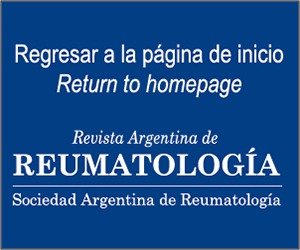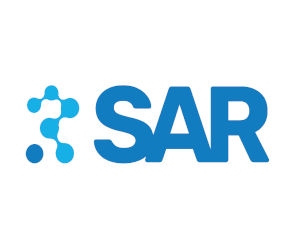Monoterapia biológica en pacientes con artritis reumatoidea en Argentina
Resumen
Introducción: La utilización de agentes biológicos para el tratamiento de la Artritis Reumatoidea (AR) es habitualmente usada en aquellos pacientes con enfermedad activa que no hayan respondido al tratamiento con drogas modificadoras de la Artritis Reumatoidea convencionales (DMARD, por sus siglas en inglés) o que hayan presentado intolerancia a las mismas. Al estado actual de la evidencia, la terapia combinada de agentes biológicos más un DMARD convencional (principalmente metotrexato) constituye el estándar de tratamiento. Sin embargo existen algunos escenarios como la intolerancia, la falta de adherencia y la aparición de eventos adversos a las DMARDs convencionales donde la monoterapia biológica emerge como una opción terapéutica válida. Según los distintos registros a nivel internacional, la frecuencia de utilización de agentes biológicos en monoterapia oscila entre 12 a 39%. Debido a la ausencia de estos datos a nivel local decidimos realizar este estudio para conocer el porcentaje de pacientes que se encuentran en monoterapia biológica y analizar las causas que llevaron a este tipo de tratamiento. Materiales y métodos: Estudio de tipo corte transversal donde se invitó a participar a diferentes centros reumatológicos distribuidos a lo largo de Argentina. Cada centro revisó las historias clínicas de los últimos 30 a 50 pacientes consecutivos vistos con AR, mayores de 18 años, que habían presentado inadecuada respuesta al tratamiento con DMARDs y que estaban bajo tratamiento biológico. Se completaba una ficha por cada paciente incluido, registrando datos demográficos, de la enfermedad y tratamientos previos. Resultados: Se incluyeron 32 centros y se evaluaron 1148 historias clínicas de pacientes con AR durante el mes de octubre y noviembre del 2012. Un 21,4% (246) de los pacientes al momento del estudio se encontraba bajo tratamiento biológico en monoterapia. Las razones de la selección del tratamiento monoterapia fueron: 45% evento adverso, 35% decisión del médico por buena evolución del paciente, 13% decisión del paciente, 7% inadecuada respuesta a las DMARDs. Los eventos adversos que llevaron al uso de monoterapia fueron: 31,9% hepatotoxicidad, 21,6% intolerancia gástrica, 9,6% estomatitis, 7,4% cefalea, 5,3% caída del cabello, entre los más frecuentes. En relación al tratamiento en combinación, el MTX fue la DMARD más utilizada (69%). Los médicos referían en un 98% de los casos estar satisfechos de la respuesta terapéutica bajo el tratamiento biológico como monoterapia. Conclusión: Una proporción significativa de pacientes con AR están siendo tratados con agentes biológicos en monoterapia. Las principales causas de esta opción terapéutica fueron intolerancia a la DMARD y decisión de discontinuación del DMARD debido a buena evolución del paciente.Citas
I. Anderson JJ, Wells G, Verhoeven AC, et al. Factors predicting the response to treatment in rheumatoid arthritis: the importance of disease duration. Arthritis Rheum 2000;43:22-9.
II. Arnett FC, Ed worthy SM, Bloch DA, et al. The Ame-rican Rheumatism Association 1987 revised criteria for the classification of rheumatoid arthritis. Arthritis Rheum 1988; 31:315-24.
III. Maldonado Ficco H, Pérez Alamino RS, Dal Para F, Lencina V, Casalla L, Benegas M. La discapacidad la-boral está relacionada con la presencia de artritis y no con un diagnóstico específico. Revista Argentina de Reumatología 2011, supplement 1:17.
IV. Hogrefe JF, Marengo M F, Schneerberger EE, Rose-mffet M, Maldonado Cocco JC, Citera G. Valor de corte de HAQ para predecir discapacidad laboral en pacientes con artritis reumatoidea. Revista Argentina de Reumatología 2009,2:23-27.
V. O'Sullivan JM, Cathcart ES. The prevalence of rheu-matoid arthritis: Follow-up evaluation of the effect of criteria on rates in Sudbury, Massachusetts. Ann In-tern Med 1972;76:573-7.
VI. Smolen JS, Landewe R, Breedveld FC, et al. EU-LAR recommendations for the management of rheumatoid arthritis with synthetic and biological disease-modifying antirheumatic drugs. Ann Rheum Dis 2010;69:964-75.
VII. Saag KG, Teng GG, Patkar NM, et al. American Co-llege of Rheumatology 2008 recommendations for the use of nonbiologic and biologic disease-modifying antirheumatic drugs in rheumatoid arthritis. Arthritis Rheum 2008;59:762-84.
VIII. Klareskog L, Van Der Heijde D, de Jager JP, et al. Therapeutic effect of the combination of etanercept and methotrexate compared with each treatment alo-ne in patients with rheumatoid arthritis: double-blind randomised controlled trial. Lancet 2004;363:675-81.
IX. van der Heijde D, Klareskog L, Landewe R, et al. Di-sease remission and sustained halting of radiographic progression with combination etanercept and metho-trexate in patients with rheumatoid arthritis. Arthritis Rheum 2007;56:3928-39.
X. Keystone EC, Kavanaugh AF, Sharp JT, et al. Ra-diographic, clinical, and functional outcomes of treatment with adalimumab (a human anti-tumor necrosis factor monoclonal antibody) in patients with active rheumatoid arthritis receiving concomitant methotrexate therapy: a randomized, placebo-contro-lled, 52-week trial. Arthritis Rheum 2004;50:1400-11.
XI. Maini RN, Breedveld FC, Kalden JR, et al. Sus-tained improvement over two years in physical function, structural damage, and signs and symptoms among patients with rheumatoid arthritis treated with infliximab and methotrexate. Arthritis Rheum 2004;50:1051-65
XII. Pappas DA, Reed GW, John A, et al. Predictors of initiating biologic monotherapy in biologic naïve pa-tients with rheumatoid arthritis (RA) in a US registry population. Arthritis Rheum 2012;64:S214.
XIII. Engel-Nitz NM, Ogale S, Kulakodlu M. Use of anti-tumor necrosis factor monotherapy and adherence with non-biologic disease-modifying anti-rheumatic drugs in combination with anti-tumor necrosis factor therapy among rheumatoid arthritis patients in a real-world setting. Arthritis Rheum2012;64:S165.
XIV. Mariette X, Gottenberg JE, Ravaud P, et al. Registries in rheumatoid arthritis and autoimmune diseases: data from the French registries. Rheumatology (Oxford) 2011;50:222-9.
XV. Lee SJ, Chang H, Yazici Y, et al. Utilization trends of tumor necrosis factor inhibitors among patients with rheumatoid arthritis in a United States observational cohort study. J Rheumatol 2009;36:1611-7.
XVI. Maini RN, Breedveld FC, Kalden JR, et al. Thera-peutic efficacy of multiple intravenous infusions of anti-tumor necrosis factor alpha monoclonal antibody combined with low-dose weekly methotrexate in rheu-matoid arthritis. Arthritis Rheum 1998;41:1552-63.
XVII. Breedveld FC, Weisman MH, Kavanaugh AF, et al. The PREMIER study: a multicenter, randomized, double-blind clinical trial of combination therapy with adalimumab plus methotrexate versus methotrexate alo-ne or adalimumab alone in patients with early, aggressive rheumatoid arthritis who had not had previous metho-trexate treatment. Arthritis Rheum 2006;54:26–37.
XVIII. Keystone EC, Genovese MC, Klareskog L, et al. Go-limumab, a human antibody to tumour necrosis factor alpha given by monthly subcutaneous injections, in acti-ve rheumatoid arthritis despite methotrexate therapy: the GO-FORWARD Study. Ann Rheum Dis 2009;68:789-96.
XIX. Van Der Heijde D, Klareskog L, Rodriguez-Valverde V, et al. Comparison of etanercept and methotrexate, alone and combined, in the treatment of rheumatoid arthritis: two-year clinical and radiographic results from the TEMPO study, a double-blind, randomized trial. Arthritis Rheum 2006;54:1063-74.
XX. Smolen J, Landewe RB, Mease P, et al. Efficacy and safety of certolizumab pegol plus methotrexate in active rheumatoid arthritis: the RAPID 2 stu-dy: a randomized controlled trial. Ann Rheum Dis 2009;68:797-804.
XXI. Keystone E, Van Der Heijde D, Mason D Jr, et al. Certolizumab pegol plus methotrexate is significantly more effective than placebo plus methotrexate in acti-ve rheumatoid arthritis: findings of a fifty-two-week, phase III, multicenter,
XXII. randomized, double-blind, placebo-controlled, para-llel-group study. Arthritis Rheum 2008;58:3319-29.
XXIII. Fleischmann R, Vencovsky J, van Vollenhoven R, et al. Efficacy and safety of certolizumab pegol mo-notherapy every 4 weeks in patients with rheumatoid arthritis failing previous disease-modifying antirheu-matic therapy: the FAST4WARD study. Ann Rheum Dis 2009;68:805-11.
XXIV. Edwards JCW, Szczepanski L, Szechinski J, et al. Efficacy of B-cell-targeted therapy with rituximab in patients with rheumatoid arthritis. N Engl J Med 2004;350:2572-81.
XXV. Aletaha D, Stamm T, Kapral T, et al. Survival and effec-tiveness of leflunomide compared with methotrexate and sulfasalazine in rheumatoid arthritis: a matched observational study. Ann Rheum Dis 2003;62:944-51.
XXVI. De La Mata J, Blanco FJ, Gomez-Reino JJ. Survival analysis of disease modifying antirheumatic drugs in Spanish rheumatoid arthritis patients. Ann Rheum Dis 1995;54:881-5.
XXVII. Grove ML, Hassell AB, Hay EM, et al. Adverse reac-tions to disease-modifying anti-rheumatic drugs in clinical practice. QJM 2001;94:309-19.
XXVIII. Papadopoulos NG, Alamanos Y, Papadopoulos IA, et al. Disease modifying antirheumatic drugs in early rheumatoid arthritis: a long-term observational study. J Rheumatol 2002;29:261-6.
XXIX. Galindo-Rodriguez G, vina-Zubieta JA, Russell AS, et al. Disappointing long-term results with disea-se modifying antirheumatic drugs: a practice based study.J Rheumatol 1999;26:2337-43.
XXX. Choquette D, Arundine M, Thomas OC. Large dis-crepancy between expected and observed ratios of biologic treated rheumatoid arthritis patients also compliant on DMARDS. Ann Rheum Dis 2011;70:197.
XXXI. Dougados M, Kissel K, Sheeran T, et al. Adding toci-lizumab or switching to tocilizumab monotherapy in methotrexate inadequate responders: 24-week symp-tomatic and structural results of a 2 year randomized controlled strategy trial in rheumatoid arthritis (ACT-RAY). Ann Rheum Dis 2013;72:43-50.
XXXII. Dougados M, Kissel K, Conaghan PG, et al. Clini-cal, radiographic, and immunogenic effects after 1 year of tocilizumab based treatment strategy with and without methotrexate in rheumatoid arthritis: the ACT RAY Study. Arthritis Rheum 2012;64:S1077.
Derechos de autor 2013 Revista Argentina de Reumatología

Esta obra está bajo licencia internacional Creative Commons Reconocimiento-NoComercial-SinObrasDerivadas 4.0.






